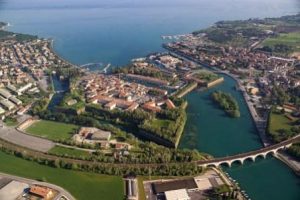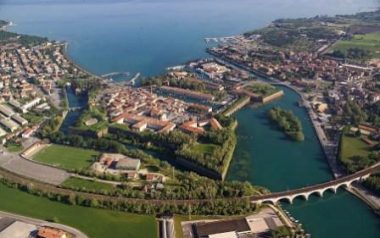Fortress of Peschiera
During the Roman period, the town, named Arilica, was already fortified and was one of the ports for the Roman fleet, both for the control on the river Mincio and for quickly moving troops from the south to the north of the lake.
Fortress of Peschiera del Garda it was further developed and strengthened during the Scaliger period starting from the XIII century, when Mastino II della Scala built the fortress, completed the walls and inserted a series of towers. In the fifteenth century the fortress with the town passed under the control of the Serenissima Republic of Venice, which, as in use at the time, modified the walls with embankments and ramparts, all designed by Guidobaldo della Rovere and managed from Michele Sanmicheli. The new fortress resumed the medieval one on five sides, but with the addition of five corners with bastions (Guerini, San Marco, Contarana, Feltrin, Tognon) and with the opening of two doors, Brescia door and Verona gate, based to the direction of the road to which they connected. In the middle of the 16th century the rocca was filled with earth, for a better use of the artillery moreover, over time the walls were still modified with the addition of ravelins placed in front of the access doors to the town. At the end of the eighteenth century, with the fall of the Serenissima and the occupation of the Austrians, the fortress of Peschiera, still considered of great importance, was further modified and strengthened with external fortifications along the road to Brescia. Then there was the Napoleonic parenthesis that, conquered Peschiera, fortified it further but on the eastern side in the direction of the Austrian enemy, with the strong Mandella Vecchia and Salvi Vecchia. Returning to the Austrians after not so long, they added other forts near the Napoleonic ones, new Mandella and Salvi Nuova; in this period Peschiera became one of the strengths of the Austrian Quadrilateral, together with Legnago, Mantua and Verona. After the first war of independence, as Peschiera was conquered, the Austrians built other strong satellites: strong Cappuccini, strong Pope, strong Laghetto, strong Saladini, strong Baccotto, strong Ardietti, strong Cavalcaselle, strong Polverina and strong Fucilazzo . With the victory of the Italians following the third war of independence, the whole fortification lost importance.


